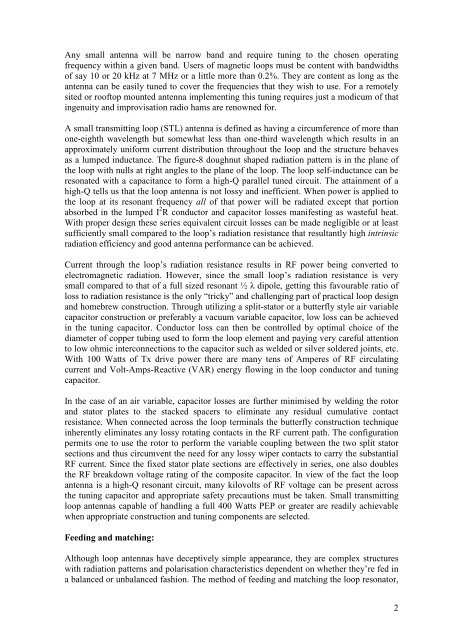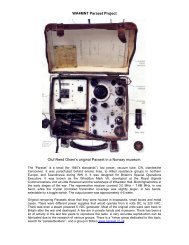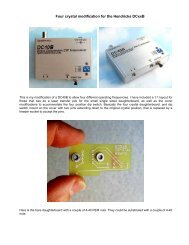Small Magnetic Loop Antenna Project - QRPBuilder.com
Small Magnetic Loop Antenna Project - QRPBuilder.com
Small Magnetic Loop Antenna Project - QRPBuilder.com
Create successful ePaper yourself
Turn your PDF publications into a flip-book with our unique Google optimized e-Paper software.
Any small antenna will be narrow band and require tuning to the chosen operating<br />
frequency within a given band. Users of magnetic loops must be content with bandwidths<br />
of say 10 or 20 kHz at 7 MHz or a little more than 0.2%. They are content as long as the<br />
antenna can be easily tuned to cover the frequencies that they wish to use. For a remotely<br />
sited or rooftop mounted antenna implementing this tuning requires just a modicum of that<br />
ingenuity and improvisation radio hams are renowned for.<br />
A small transmitting loop (STL) antenna is defined as having a circumference of more than<br />
one-eighth wavelength but somewhat less than one-third wavelength which results in an<br />
approximately uniform current distribution throughout the loop and the structure behaves<br />
as a lumped inductance. The figure-8 doughnut shaped radiation pattern is in the plane of<br />
the loop with nulls at right angles to the plane of the loop. The loop self-inductance can be<br />
resonated with a capacitance to form a high-Q parallel tuned circuit. The attainment of a<br />
high-Q tells us that the loop antenna is not lossy and inefficient. When power is applied to<br />
the loop at its resonant frequency all of that power will be radiated except that portion<br />
absorbed in the lumped I 2 R conductor and capacitor losses manifesting as wasteful heat.<br />
With proper design these series equivalent circuit losses can be made negligible or at least<br />
sufficiently small <strong>com</strong>pared to the loop’s radiation resistance that resultantly high intrinsic<br />
radiation efficiency and good antenna performance can be achieved.<br />
Current through the loop’s radiation resistance results in RF power being converted to<br />
electromagnetic radiation. However, since the small loop’s radiation resistance is very<br />
small <strong>com</strong>pared to that of a full sized resonant ½ λ dipole, getting this favourable ratio of<br />
loss to radiation resistance is the only “tricky” and challenging part of practical loop design<br />
and homebrew construction. Through utilizing a split-stator or a butterfly style air variable<br />
capacitor construction or preferably a vacuum variable capacitor, low loss can be achieved<br />
in the tuning capacitor. Conductor loss can then be controlled by optimal choice of the<br />
diameter of copper tubing used to form the loop element and paying very careful attention<br />
to low ohmic interconnections to the capacitor such as welded or silver soldered joints, etc.<br />
With 100 Watts of Tx drive power there are many tens of Amperes of RF circulating<br />
current and Volt-Amps-Reactive (VAR) energy flowing in the loop conductor and tuning<br />
capacitor.<br />
In the case of an air variable, capacitor losses are further minimised by welding the rotor<br />
and stator plates to the stacked spacers to eliminate any residual cumulative contact<br />
resistance. When connected across the loop terminals the butterfly construction technique<br />
inherently eliminates any lossy rotating contacts in the RF current path. The configuration<br />
permits one to use the rotor to perform the variable coupling between the two split stator<br />
sections and thus circumvent the need for any lossy wiper contacts to carry the substantial<br />
RF current. Since the fixed stator plate sections are effectively in series, one also doubles<br />
the RF breakdown voltage rating of the <strong>com</strong>posite capacitor. In view of the fact the loop<br />
antenna is a high-Q resonant circuit, many kilovolts of RF voltage can be present across<br />
the tuning capacitor and appropriate safety precautions must be taken. <strong>Small</strong> transmitting<br />
loop antennas capable of handling a full 400 Watts PEP or greater are readily achievable<br />
when appropriate construction and tuning <strong>com</strong>ponents are selected.<br />
Feeding and matching:<br />
Although loop antennas have deceptively simple appearance, they are <strong>com</strong>plex structures<br />
with radiation patterns and polarisation characteristics dependent on whether they’re fed in<br />
a balanced or unbalanced fashion. The method of feeding and matching the loop resonator,<br />
2





